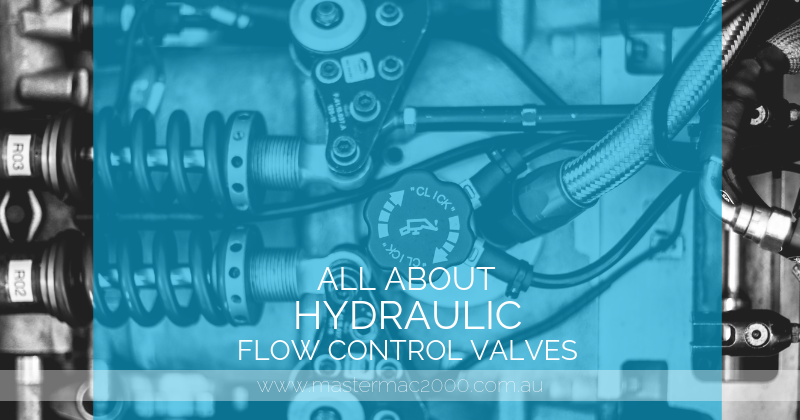All About Hydraulic Flow Control Valves

It is known that flow control valves are used in regulating pressure and flow rate of liquids or gases into and out of a pipeline. They are one of the essentials in optimising system performance that rely on a port or a flow passage with a variable flow area. Here are the things you should know about a flow control valve.
Functions
In hydraulic systems, flow control valves are used to control the flow rate to motors and cylinders, and as a result of that, the speed of these said components is regulated. In simple terms, such valves control the flow rate of a hydraulic circuit. But not only that, they regulate the energy transfer rate at a specific pressure.
How it works
Hydraulic flow control valve designs vary depending on its purpose and the intended specific application. That’s why it’s important to understand how they work to make the right decisions in selecting the appropriate valve, be it a ball, butterfly, diaphragm, needle, or plug control valve.
The truth about the simplest flow control valves is that they have an aperture that opens or closes to accelerate or slow down the rate of the flow. And one of these is the ball valves, which consist of a ball attached to a handle. A hole can be observed through the centre of the ball that aligns with valve openings when the handle is turned, permitting the flow. To block the flow, the handle should be turned to put the hole perpendicular to the valve openings.
Other types of flow control valves operate in a similar way. For instance, a butterfly valve has an internal metal plate that is attached to a pivoting mechanism. Once the mechanism is turned, the plate opens or closes. With needle valves, they have a valve stem and an adjustable needle that allows or restricts the flow of liquid. It is the needle that blocks the flow of the fluid, allowing the free flow of liquid or obstruct the flow to varying degrees. With this, the greater and more precise the control is over the flow rate.
There are many options for controlling flow, especially in hydraulic circuits. Ranging from the simplest to the most sophisticated ones, which include hybrids that pair hydraulic valve actuation with electronic controls. Other options count bypass flow regulators, deceleration valves, flow dividers and regulators, priority valves, proportional flow-logic valves, etc.
Design factors
Designing a flow control valve for a specific application requires deliberate consideration of the factors that can influence durability, flow, and performance. Such include allowable leakage limit once the valve is closed, connectivity to the process, liquid’s corrosive property, maximum noise tolerance, and what have you.
Along with the minimum and maximum flow rates, fluid density also plays a role in determining the proper size for the valve. The material to use for the valve and the corrosive property of the liquid should be considered as well.
Want to learn more about flow control valves? Contact us at Mastermac2000.com.au.

About MasterMac2000: Your Trusted Pneumatic & Process Automation Partner.
LEADING THE INDUSTRY: Established in 1989, MasterMac2000 has grown to become one of Australia's largest privately owned pneumatic and process automation companies. We stock top-quality brands like Univer, Mack, Tolomatic, Mac, Piab, American, and Rotoflux in Brisbane.
SERVING QLD & NORTHERN NSW: We proudly service Queensland and Northern New South Wales for all your pneumatic and process equipment needs. Our mission is to provide the best pre and post-sales support while actively expanding our client base.
SOURCING HARD-TO-FIND PARTS: Not only do we stock quality components, but we also excel at sourcing those elusive, hard-to-find parts. With our extensive database and global network of contacts, getting the parts you require is as easy as a call to our highly skilled, professional sales team.
DEDICATED TO YOUR SUCCESS:
- Decades of expertise in pneumatics & process automation
- Carefully curated selection of world-class brands
- Exceptional sourcing capabilities for speciality parts
- Knowledgeable sales staff dedicated to finding solutions
- Unwavering commitment to customer service excellence
About The Author
Stuart Havill
Stuart Havill is the owner and manager of MasterMac2000, Queensland's largest privately owned pneumatic and process valve company.
With his early working career as a maintenance fitter for Boral in 1992, Stuart has spent his life in the field of pneumatics and process equipment. He gained extensive experience in plant design, maintenance, repairs, fabrication, and site management.
In 1996, he transitioned to a pneumatic sales technician role at MasterMac2000, where he excelled in key account management, providing cost-effective solutions, and managing a sales team of 9 employees.
Since 2002, Stuart has been the manager at MasterMac2000, overseeing the company's growth and establishing it as a leader in pneumatic automation and process valve engineering. His expertise spans customer training, CRM setup, industrial compressor sizing and installation, and turn-key project management.
Under Stuart's leadership, MasterMac2000 has been servicing the industry since 1988, with 5 full-time sales representatives covering northern rivers NSW, Queensland, Northern Territory, and PNG. The company prides itself on providing the best-priced solutions to all customers in the marketplace.
View Stuart’s LinkedIn profile to learn more about his expertise in pneumatics and process equipment.